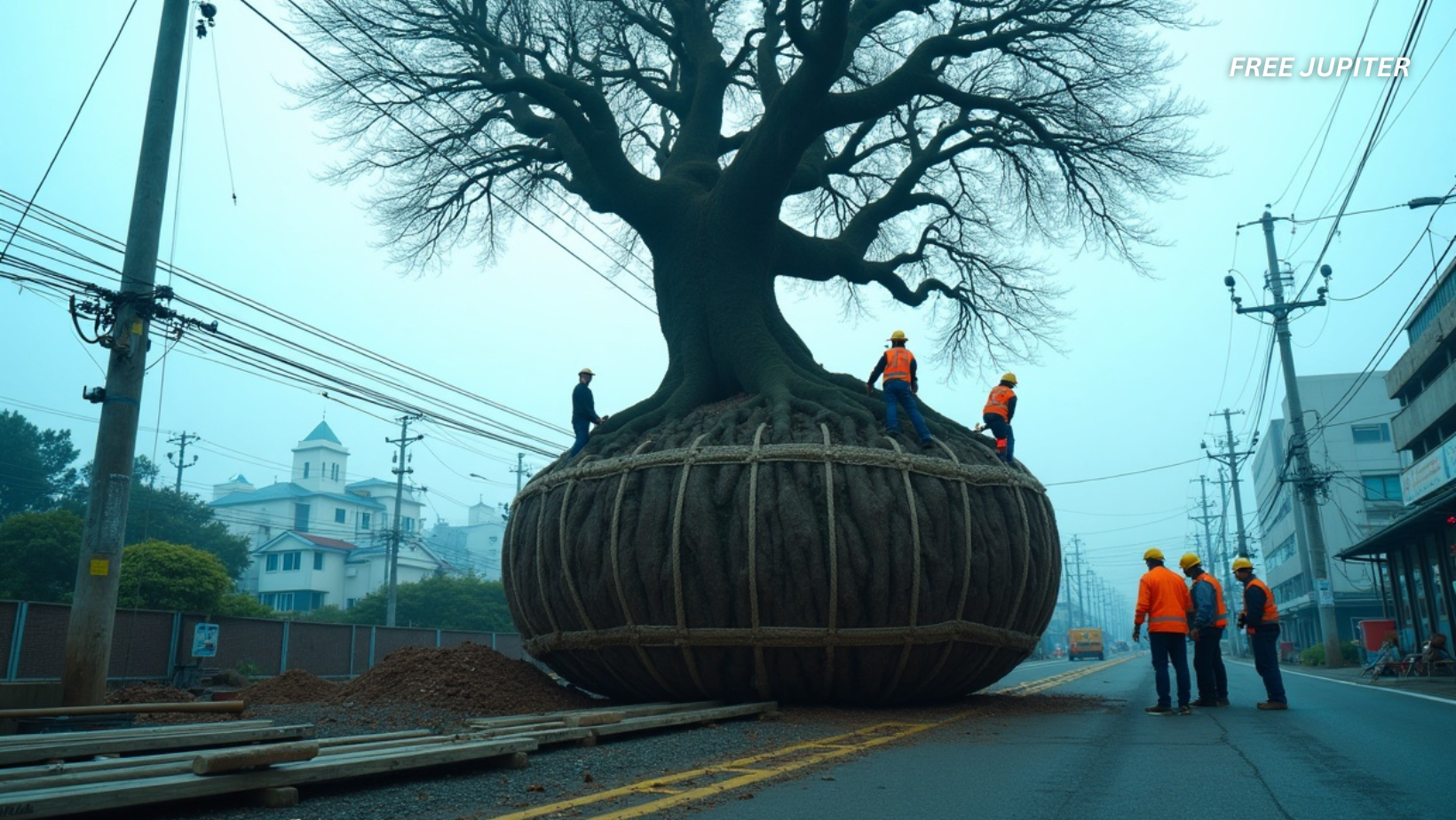Friendly Note: FreeJupiter.com shares general info for curious minds 🌟 Please fact-check all claims—and always check health matters with a professional 💙
In most parts of the world, if a tree is standing in the way of a new road, building, or parking lot, the usual fate is swift and sad: cut it down, clear the area, and carry on. But in Japan, things work a little differently. Rather than bulldozing through nature, people often go to extraordinary lengths to protect it—especially when it comes to trees.
Not Just Plants—Living Landmarks
To understand this tree-moving mindset, you first have to recognize how deeply rooted (yes, pun intended) trees are in Japanese culture. They’re not merely green decoration. Many are sacred, symbolic, and downright historical.
Some trees are older than the buildings that surround them. They’ve witnessed wars, festivals, and generations of families growing up under their branches. These aren’t just trees—they’re living landmarks.
One unforgettable example? A 70-ton camphor tree in Tokyo. This massive tree—already one of the oldest natural giants in the city—stood in the way of a development project. Rather than cut it down, the decision was made to relocate it. With more than 70 workers, special cranes, and inflatable rollers, the tree was carefully uprooted and transported to a new spot. Not a single leaf was taken for granted.
The Art and Science of Moving Trees
Moving a fully grown tree is a serious operation—not just for its size, but for its life. Mature trees aren’t used to being disturbed. They’ve spent decades sinking their roots deep into the soil, forming delicate systems of nourishment and support underground. Uprooting them without care would be like yanking someone out of bed mid-dream—it can lead to shock, and sometimes death.
That’s why the process is so precise. First, arborists, or tree-care experts, assess the health of the tree. Is it strong enough to survive the move? Can its roots handle the disturbance?
If all signs point to yes, the move is carefully timed—ideally during fall or winter, when the tree is dormant. This lowers the risk of what’s called transplant shock, a kind of tree trauma that occurs when roots are disturbed while the tree is still actively growing.
Next, the root ball—the critical base of the tree that connects it to the earth—is dug out in stages. The tree is sometimes pruned and its branches tied to prevent damage during the move. Massive cranes then lift the tree out of the ground like a precious artifact. Once it’s secured, it’s placed onto trucks with supportive cushioning like inflatable rollers or padded frames, then gently driven to its new home.
And the work doesn’t stop there.
Once replanted, the tree must be nursed back into comfort. It’s given water, nutrients, and sometimes even shade to help it reestablish itself. Workers often monitor the tree for months or even years afterward. With the right care, many of these moved trees not only survive—they thrive.
Read more: Japan Has 9 Million Empty Homes—And Some Are Being Given Away
Nature and Technology—Coexisting with Grace
What makes Japan’s tree-moving practices stand out isn’t just the effort—it’s the philosophy. Japan is one of the most technologically advanced countries in the world, yet it still holds tight to ancient traditions. In Shinto belief, for instance, trees can be sacred, home to spirits called kami. To destroy one unnecessarily could be seen as a form of spiritual disrespect.
This deep respect for nature has led to some truly remarkable feats.
Giant Trees at Narita Airport Find a Second Home
A Major Expansion Meets Natural Resistance
Narita International Airport, one of Japan’s busiest gateways, is no stranger to growth. But when a major expansion project called for the clearing of land, several massive, mature trees—some of them over 20 meters tall—stood directly in the way. These included elegant Japanese zelkova and robust oak trees, both native species cherished for their longevity and beauty.
When the Community Spoke, Authorities Listened
As plans to remove the trees went public, they sparked immediate concern among residents, environmentalists, and even frequent fliers. For many, these trees weren’t just obstacles—they were pieces of living history. The public outcry was swift and passionate, demanding a solution that didn’t involve the sound of chainsaws and loss.
In an impressive show of civic engagement, the community pushed for the trees to be saved, not sacrificed. And remarkably, the airport authorities listened.
The Bold Decision to Relocate, Not Remove
After several rounds of discussions, a compromise was made: the trees would not be destroyed but instead relocated to a newly built tree sanctuary, right on the airport grounds. Though this was a costlier and more time-consuming route, it honored both nature and the people who advocated for it.
Moving trees of this size and age is no ordinary feat. Teams of specialists carefully prepared each tree for transport, using cranes, root-binding methods, and inflatable rollers to gently lift them from the ground. This wasn’t just landscaping—it was tree surgery on a massive scale.
Read more: Scientists Can Now Create Real Diamonds From Scratch in 15 Minutes—No Heat Required
A Green Sanctuary Within a Concrete Hub
The relocated trees were placed in what’s now known as the Narita Airport Green Zone, a peaceful park area designed to give these trees a second chance at life. It’s not just a holding area—it’s a thoughtfully planned, green breathing space nestled in the midst of a bustling airport complex.
Travelers can now stroll through this shaded haven, sit beneath the leafy canopy, and unwind between flights. Some benches even feature plaques telling the story of how these trees came to be there—turning a practical relocation into an inspiring mini history lesson.
Is Tree Relocation Just a Japanese Thing?
Not at all! Tree-moving has happened in many countries throughout history.
- In China, royal gardens during ancient dynasties were carefully curated, often involving the relocation of trees to create poetic, harmonious landscapes.
- In Europe, wealthy landowners during the 18th and 19th centuries sometimes had massive trees transplanted to decorate their private estates.
- In the United States, large-scale tree-moving has been used in conservation efforts and even theme parks—Disneyland, for instance, has famously moved trees to preserve its storytelling environments.
But Japan takes this to another level. Tree relocation is more commonplace, more culturally supported, and more routinely integrated into public planning than in most other nations.
Why It Matters Today
As cities expand and the demand for infrastructure grows, nature often ends up being the casualty. But Japan’s approach offers a different path—one where modern life and the natural world don’t have to be enemies.
Tree relocation is not cheap, and it’s not easy. But it shows that with enough care and intention, it’s possible to honor both progress and preservation.
And while moving a tree won’t solve every environmental problem, it’s a symbolic and practical gesture: one that says, “This life matters. This story is worth saving.”
Read more: Lab Study Shows Dandelion Root Kills Over 90% of Colon Cancer Cells In Just Two Days
Final Thought: Let Trees Travel, Too
In a world racing toward the future, Japan’s practice of moving trees—rather than removing them—is a quiet, powerful act of respect. It’s a reminder that development doesn’t have to mean destruction. That history, culture, and nature can move forward together.
So the next time you see a tree standing tall in a city, take a moment to appreciate it. In Japan, someone might have lifted it carefully, like a sleeping elder, and carried it to that very spot—roots and all.










